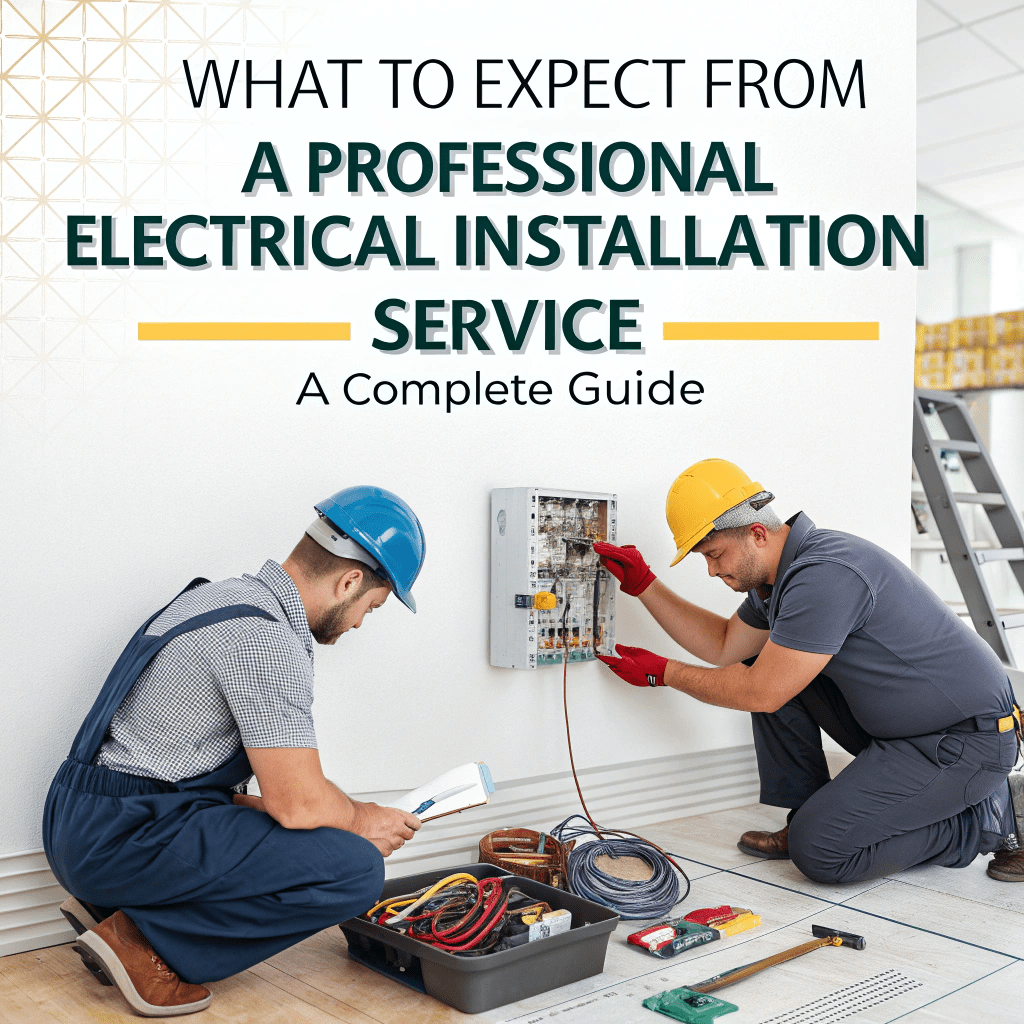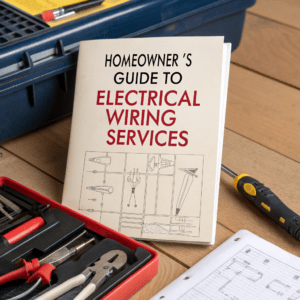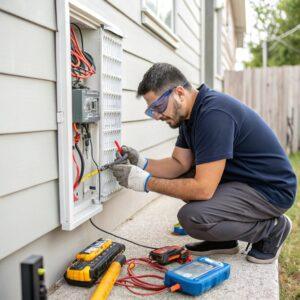What to Expect from a Professional Electrical Installation Service: A Complete Guide
Electrical issues can be dangerous, costly, and disruptive. Poor electrical installation service puts your safety and property at risk, whether you’re building a new home, renovating an office, or upgrading an outdated system. Ignoring professional help or cutting corners can lead to code violations, frequent outages, or electrical fires. You’re left vulnerable to long-term damage and expensive repairs without proper wiring, inspections, and expert planning.
That’s why hiring a professional electrical installation service is essential. This guide will walk you through each process stage—from the first consultation to the final inspection and long-term maintenance. You’ll also learn why quality electrical wiring and timely repairs are critical to keeping your system safe, efficient, and up to code.
Table of Contents:
|
|
|
|
|
|
|
|
|
|
|
|
|
Step 1: The Initial Consultation and On-Site Evaluation
Every successful project starts with a clear understanding of the customer’s needs.
When you contact a professional electrician, the first step is usually a consultation and on-site visit. This allows the electrician to assess your environment, listen to your concerns, and create a customized plan.
During this visit, the electrician will:
- Evaluate your existing electrical setup (if you’re upgrading or renovating)
- Discuss your energy needs based on appliances, devices, and lighting preferences.
- Examine your blueprint or floor plan (for new builds)
- Take measurements and photos for reference.
- Spot any immediate safety concerns or code violations.
You’ll also have the opportunity to share your vision, whether it’s installing recessed lighting, outdoor outlets, smart switches, or backup power systems.
Step 2: Electrical Load Calculation and System Design
Once your requirements are precise, your electrician will begin planning your electrical system.
This includes:
- Calculating your total electrical load – How much power your home or business will require at peak times
- Designing the circuitry – Planning how many outlets, light fixtures, switches, and dedicated circuits you need
- Choosing panel size – Most homes require 100 to 200 amps, depending on the number of appliances and systems used.
- Planning future expansion—If you plan to add solar panels, an EV charger, or more appliances later, your electrician will design accordingly.
This step ensures your system won’t overload, short-circuit, or waste energy. A good design lays the groundwork for a safe, functional, scalable electrical system.
Step 3: Receiving a Clear and Transparent Quotation
With the system designed, the electrician will provide a written estimate for the full scope of work.
A reliable quote will include:
- Itemized list of parts and materials (wiring, panels, breakers, boxes, outlets, etc.)
- Labor costs (broken down by task or total hours)
- Fees for permits or inspections
- Estimated time frame for project completion
- Warranty details on equipment and artistry
Clear communication at this stage helps you avoid hidden charges and keeps expectations realistic. Make sure you understand every item in the quote before signing.
Step 4: Permits and Project Scheduling
In most areas, the local building department must permit and inspect major electrical work. This is to protect you and ensure the work meets all safety codes.
Your electrician will take care of the following:
- Applying for and obtaining the necessary permits
- Scheduling work dates based on your availability
- Coordinating with other contractors (plumbers, HVAC technicians, etc.) when needed
- Informing you of expected power shutdowns or access requirements
Permit approval times vary, but professional electricians usually have experience navigating local codes and can streamline the process.
Step 5: Electrical Installation Wiring—The Core of the Job
Once permits are secured, the real work begins. Wiring is the heart of any electrical installation service and must be done precisely.
The electrician will:
- Run wires through walls, ceilings, floors, and conduits.
- Install electrical boxes for outlets, switches, lights, and equipment in precise locations.
- Use copper wiring or other approved materials rated for your system’s voltage and load.
- Ground all wiring properly to prevent shocks and electrical fires.
- Secure everything according to NEC (National Electrical Code) guidelines.
Mistakes in wiring can be dangerous. That’s why only trained, licensed professionals should handle it.
Step 6: Panel Installation and Circuit Breaker Configuration
The electrical panel is your system’s central hub. It manages power distribution and protects your home or business from overloads.
Professional panel installation includes:
- Installing the main service panel (and subpanels if needed)
- Connecting circuit breakers with the correct amperage rating
- Grouping circuits logically (e.g., lighting, kitchen, HVAC, outlets)
- Labeling each breaker for easy identification
- Ensuring grounding and bonding are up to code
This setup makes it easier to manage your electricity and helps with future maintenance or upgrades.
Step 7: Testing, Troubleshooting, and Quality Checks
Before finalizing the job, the electrician performs comprehensive testing to ensure everything operates safely and efficiently.
This testing phase may include:
- Checking voltage levels at all outlets and fixtures
- Verifying that circuit breakers trip properly during overload conditions
- Ensuring GFCI (Ground Fault Circuit Interrupters) and AFCI (Arc Fault Circuit Interrupters) work correctly
- Troubleshooting any issues with connections, grounding, or short circuits
Thorough testing gives you peace of mind that your system won’t just work—it will work safely.
Step 8: Final Inspection by Local Authorities
Once the electrician is satisfied with the work, the project is ready for a final inspection by a licensed building official.
The inspector will:
- Examine the installation for compliance with local and national codes.
- Confirm that all permits were pulled and closed.
- Inspect panels, wiring, grounding, and device installation.
- Approve the project or provide a correction notice if anything needs adjustment.
Only after passing this inspection can the system be considered officially complete.
Step 9: Client Walkthrough and System Orientation
With approvals, your electrician will guide you through the newly installed system.
You’ll learn:
- How to operate the main panel and circuit breakers
- What each breaker controls (often labeled inside the panel door)
- Where safety features like surge protectors and GFCIs are located
- How to identify signs of issues and when to call for electrical repairs
- What’s covered by the warranty, and how to request service if needed
This step ensures you’re confident and informed about your new electrical system.
Step 10: Ongoing Electrical Repairs and Preventive Maintenance
Electrical systems require occasional upkeep to remain safe and efficient.
A qualified electrician can help with:
- Routine inspections to identify worn or outdated components
- Electrical repairs for issues like flickering lights, non-working outlets, or tripping breakers
- Upgrading old wiring in older homes
- Installing surge protection, smart home systems, or energy-saving devices
- Responding to emergencies such as burnt wires or storm damage
Proactive maintenance prevents minor issues from becoming dangerous or expensive.
Why Professional Electrical Installation Service of Wiring Matters
You may be tempted to cut corners or attempt DIY wiring, but the risks aren’t worth it. Professional electrical installation wiring ensures that your system:
- Complies with all safety codes and regulations
- Uses the right materials rated for your home or building
- It avoids overloading, fire hazards, and electric shocks.
- Enhances energy efficiency
- Stands the test of time, reducing the need for frequent repairs
Whether a new building or a renovation, professional electrical installation service provides reliability, safety, and peace of mind.
Frequently Asked Questions (FAQs)
- How long does a complete electrical installation service take?
Most residential projects take 3 to 7 days, while commercial jobs can take longer based on size and complexity.
- Can I remain in my house during the installation?
Yes, you may experience temporary power outages or need to avoid certain areas during work.
- How often should I get electrical maintenance?
Aim for a system check every 1 to 3 years, especially if your building is older.
- What are the signs I need electrical repairs?
Look for burning smells, buzzing sounds, hot outlets, frequent breaker trips, or flickering lights.
- Is DIY electrical work legal or safe?
In most jurisdictions, doing major electrical work without a license is illegal and hazardous. Always hire a pro.
Final Thoughts: Trust NT Electrician for Safe and Reliable Service
Electrical installation is more than just pulling wires—it’s about safety, planning, precision, and expertise. A professional electrician takes the guesswork out of the process and ensures everything is code-compliant, future-ready, and tailored to your needs.
Whether you’re building a home, upgrading your office, or renovating a retail space, trust NT Electrician to handle your electrical installation, wiring, and repairs with the highest standards of care and craftsmanship.
Need help with an electrical installation service? Contact NT Electrician today and power your space safely, efficiently, and reliably.






